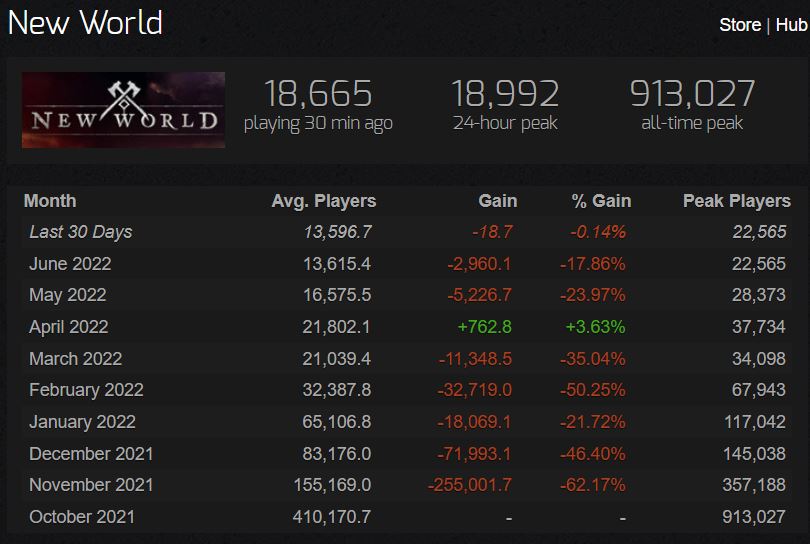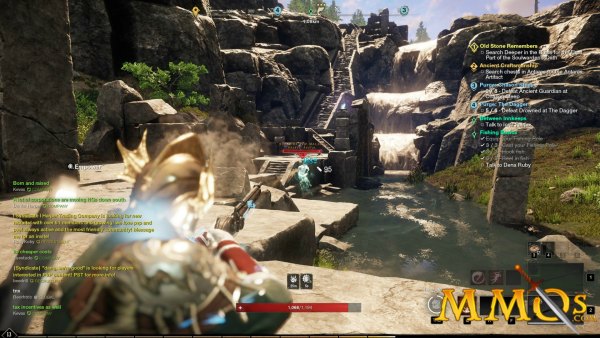New World - Amazon’s $200+ Million Blunder

The story of New World’s successful launch and immediate crash is by now well documented. Amazon’s first big launch title was (and still is) plagued by bugs, missing content, and balance issues. From a high of over 900,000 concurrent players, New World now sits at an average daily player count of 13,600 with no floor in sight (as of June, 2022). The stellar launch of Lost Ark, a Korean MMORPG for which Amazon serves as publisher, is bound to continue siphoning away New World players.

What is less discussed in this saga is just how much money Amazon has lavished on New World and how little it got in return for its troubles. In order to get a clear understanding, a brief summary of Amazon Game Studios is in order. Amazon’s foray into games started in 2011 with the release of the Amazon Appstore. A series of unremarkable mobile and Facebook web games were then released between 2012-2018. The studio’s first PC title, Breakaway was canceled in 2018 with its development team shifting to the hero shooter Crucible and to New World. 2019 saw the release of The Grand Tour Game for PS4/XB1. That title proved a failure and was removed from retail and digital store fronts soon after. Multiple unnamed projects were canceled that same year including a project codenamed Intensity which was to be a Fortnite inspired Battle Royale. An earlier project, codenamed Nova that was to be a League of Legends inspired MOBA was canceled, in 2017. 2020 saw the cancellation of Crucible following a brief but disastrous launch. 2020 also saw the cancellation of an unnamed Lord of the Rings themed MMORPG that Amazon had been involved with. That left New World as the studio’s last remaining named project.
With multiple teams reassigned to help with New World, there is no question that this was Amazon’s flagship video game title. It's important to emphasize this because credible reports by insiders have stated that Amazon is spending $500 million a year on its Games studio. That figure does not include Twitch, or the video game streaming service Luna which are managed by a separate division. While no official figures are available, that means New World has likely burned through at a minimum $200 million during its development. The more likely figure is $500 million or more, considering the game was first announced in 2016 but did not see release until September 2021. Even if we take the ultra conservative figure of $200 million, that would make New World among the most expensive MMORPGs ever produced, surpassed only by the controversial crowd-funded project Star Citizen.
What makes that astronomical development budget even more startling is the fact that New World is rather feature poor for a MMORPG. Originally envisioned as a PvP focused survival game like Rust, New World went through many revisions before it became the game it is today. Early design decisions were difficult to adjust and some of those limitations can be seen in the finished game. Monster designs are notoriously limited, with the same few models being recycled across every region. Servers have a laughably small population cap of around 2000 despite New World having first party access to Amazon’s AWS cloud service and Lumberyard game engine. The rapid transition from a PvP focused game to a standard PvE focused MMORPG with consensual PvP options proved to be both expensive and incomplete.
Interviews with insiders pin some of the blame for cost overruns and delayed schedules on the game engine itself. Forked from a licensed version of CryEngine, Lumberyard lacked both documentation and a pool of developers with experience coding on the platform. Star Citizen is perhaps the only other title still committed to using Lumberyard outside Amazon’s first party initiatives. Needless to say, development progress on that title is not a vote of confidence for Lumberyard in the eyes of outside observers. Even Lumberyard itself seems to be largely sidelined by Amazon. In July of 2021 Amazon open sourced much of Lumberyard and transferred it to the Linux Foundation under the new name Open 3D Engine (O3DE). Making the engine available to the open source community is certainly commendable, but hints at Amazon’s failure to turn the game engine into a commercially viable product that can compete against rivals like the Unreal and Unity engines.
The lone bright star in Amazon Game Studio’s constellation is now Lost Ark which has had the biggest MMORPG launch in recent memory. Peaking at over 1,300,000 concurrent players in the days after its release, Lost Ark now ranks second only to PUBG in Steam’s top player count of all time list. Amazon’s experience in first party game development has been a humbling experience, but that is a risk one takes when trying to run before learning to walk. Perhaps several years as a game publisher will give Amazon the experience and confidence it needs to wade back into game development in the years to come. But by then the sun may have already set on New World.
Further Reading:
Amazon Game Studios Struggles to Find a Hit (Bloomberg)




